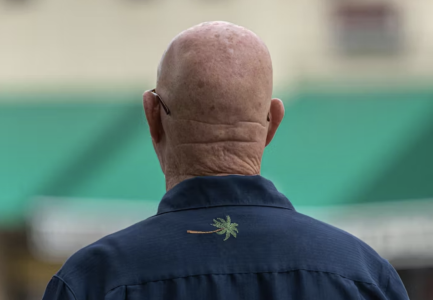Science is bringing hair back—Would you say yes to a new you?
- Replies 4
Imagine a world where going bald is no longer an inevitable part of ageing, but a personal choice—like deciding whether to wear a hat or not.
Well, that world might be closer than you think, thanks to a groundbreaking Australian clinical trial that’s turning heads (and possibly growing hair on them, too!).
For decades, many of us have watched our hairlines recede or our crowns thin, often with a resigned sigh and a collection of half-used bottles promising miraculous regrowth.
But now, a team of Aussie researchers is on the cusp of making baldness 'perfectly optional'—and they’re looking for 150 volunteers to help them cross the finish line.
The star of this story is minoxidil, a medication originally designed to treat high blood pressure.
In a twist worthy of a medical drama, doctors noticed that patients taking minoxidil started sprouting more hair. This unexpected side effect led to the development of topical solutions like Rogaine, which many of us have seen advertised (or even tried ourselves).

But here’s where things get really interesting. Professor Rodney Sinclair, a leading dermatologist, has spent 15 years fine-tuning a new way to use minoxidil—not as a lotion, but as a tablet that dissolves under your tongue.
According to Professor Sinclair, this method has shown even greater success than the old-fashioned topical treatments.
'If we can get this through the regulatory pathways and make it available in pharmacies, it may well be that baldness becomes something that is perfectly optional,' he says. Imagine that: choosing your hairstyle based on preference, not genetics!
Andrea Demuru, one of the trial participants, knows the struggle all too well. 'I started purchasing products, shampoos and tablets and everything I could get my hands on,' he shares.
'The only thing that many people end up doing is wasting a lot of money.' Sound familiar? You’re not alone—hair loss is a multi-billion-dollar industry, and most of us have tried at least one 'miracle cure' that didn’t quite deliver.
But this new approach is different. After two successful trial phases, the final phase is underway, focusing on rigorous measurement of hair growth and, crucially, how patients feel about their results.
'We also have to measure whether the number of hairs we grow is actually meaningful to the patient, whether it shifts the dial in terms of how they look, how they feel about themselves and whether they can see that it’s working,' Professor Sinclair explains.
Unlike many over-the-counter products, this treatment is being put through the wringer with proper clinical trials.
Over 15 years, Professor Sinclair’s team has treated nearly 30,000 patients, adjusting doses and perfecting the technique. The final phase will not only count new hairs but also ask volunteers how the changes affect their confidence and quality of life.
If all goes well and the treatment receives regulatory approval, it could be available in Australian pharmacies within two years. That’s right—by 2026, you might be able to stroll into your local chemist and pick up a prescription to keep your locks lush.
Of course, as with any medication, it’s important to remember that what works for one person might not work for another, and there can be side effects. That’s why these clinical trials are so important—they help ensure that new treatments are both safe and effective.
Source: Dr. Kopelman / Youtube.
While we wait for this potential breakthrough, let’s not forget the other ways people manage hair loss. Wigs, hairpieces, and clever styling tricks have helped many of us feel more confident. There are also surgical options like hair transplants, though these can be expensive and aren’t for everyone.
And let’s not overlook the growing movement of embracing baldness! Many famous and everyday Aussies alike are rocking the bald look with pride. After all, confidence is the best accessory, whether you have a full head of hair or not.
Read more: There was a time when rare cancers meant no hope—this new treatment changes that

Have you tried minoxidil or any other hair loss treatments? Would you consider joining a clinical trial like this? Or have you embraced your natural look and never looked back? Share your stories, tips, and questions in the comments below!
Well, that world might be closer than you think, thanks to a groundbreaking Australian clinical trial that’s turning heads (and possibly growing hair on them, too!).
For decades, many of us have watched our hairlines recede or our crowns thin, often with a resigned sigh and a collection of half-used bottles promising miraculous regrowth.
But now, a team of Aussie researchers is on the cusp of making baldness 'perfectly optional'—and they’re looking for 150 volunteers to help them cross the finish line.
The star of this story is minoxidil, a medication originally designed to treat high blood pressure.
In a twist worthy of a medical drama, doctors noticed that patients taking minoxidil started sprouting more hair. This unexpected side effect led to the development of topical solutions like Rogaine, which many of us have seen advertised (or even tried ourselves).

Australian researchers are seeking 150 volunteers for the final stage of a clinical trial testing a re-purposed blood pressure medication, Minoxidil, as a treatment for baldness. Image source: Donald Teel / Unsplash. Disclaimer: This is a stock image used for illustrative purposes only and does not depict the actual person, item, or event described.
But here’s where things get really interesting. Professor Rodney Sinclair, a leading dermatologist, has spent 15 years fine-tuning a new way to use minoxidil—not as a lotion, but as a tablet that dissolves under your tongue.
According to Professor Sinclair, this method has shown even greater success than the old-fashioned topical treatments.
'If we can get this through the regulatory pathways and make it available in pharmacies, it may well be that baldness becomes something that is perfectly optional,' he says. Imagine that: choosing your hairstyle based on preference, not genetics!
Andrea Demuru, one of the trial participants, knows the struggle all too well. 'I started purchasing products, shampoos and tablets and everything I could get my hands on,' he shares.
'The only thing that many people end up doing is wasting a lot of money.' Sound familiar? You’re not alone—hair loss is a multi-billion-dollar industry, and most of us have tried at least one 'miracle cure' that didn’t quite deliver.
But this new approach is different. After two successful trial phases, the final phase is underway, focusing on rigorous measurement of hair growth and, crucially, how patients feel about their results.
'We also have to measure whether the number of hairs we grow is actually meaningful to the patient, whether it shifts the dial in terms of how they look, how they feel about themselves and whether they can see that it’s working,' Professor Sinclair explains.
Unlike many over-the-counter products, this treatment is being put through the wringer with proper clinical trials.
Over 15 years, Professor Sinclair’s team has treated nearly 30,000 patients, adjusting doses and perfecting the technique. The final phase will not only count new hairs but also ask volunteers how the changes affect their confidence and quality of life.
If all goes well and the treatment receives regulatory approval, it could be available in Australian pharmacies within two years. That’s right—by 2026, you might be able to stroll into your local chemist and pick up a prescription to keep your locks lush.
Of course, as with any medication, it’s important to remember that what works for one person might not work for another, and there can be side effects. That’s why these clinical trials are so important—they help ensure that new treatments are both safe and effective.
Source: Dr. Kopelman / Youtube.
While we wait for this potential breakthrough, let’s not forget the other ways people manage hair loss. Wigs, hairpieces, and clever styling tricks have helped many of us feel more confident. There are also surgical options like hair transplants, though these can be expensive and aren’t for everyone.
And let’s not overlook the growing movement of embracing baldness! Many famous and everyday Aussies alike are rocking the bald look with pride. After all, confidence is the best accessory, whether you have a full head of hair or not.
Read more: There was a time when rare cancers meant no hope—this new treatment changes that
Key Takeaways
- Australian researchers are seeking 150 volunteers for the final stage of a clinical trial testing a re-purposed blood pressure medication, Minoxidil, as a treatment for baldness.
- The trial is centred on a tablet formulation dissolved under the tongue, which Professor Rodney Sinclair says may make baldness 'perfectly optional' if approved.
- Two phases of trials have already been completed, with the final phase set to include detailed measurement of hair growth and patient satisfaction.
- If the medication passes regulatory approval, it could be available in pharmacies across Australia within two years.
Have you tried minoxidil or any other hair loss treatments? Would you consider joining a clinical trial like this? Or have you embraced your natural look and never looked back? Share your stories, tips, and questions in the comments below!







